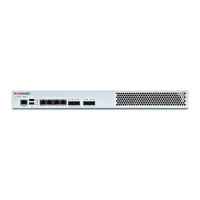Tunnel Routing Load Balancing & Fault Tolerance
Group Tunnels
Local IP : Configure local IP address for tunnels in the tunnel group. The local IP addresses here are
the localhost IP defined on the WAN links of local FortiWAN. According to the WAN type
defined on WAN links, here are several types of Local IP for options.
l Local IP: Configure local IP address for tunnels in the tunnel group. The local IP
addresses here are the localhost IP defined on the WAN links of local FortiWAN.
According to the WAN type defined on WAN links, here are several types of Local
IP for options.
l Static-IP WAN link without NAT on local side: If the WAN link of local FortiWAN
you want to employ for the tunnel is configured with a static IP and there is no NAT
translated for the WAN link, please select “IPv4 Address” and configure it with the
static IP of the WAN link.
l Static-IP WAN link with NAT on local side: If the WAN link of local FortiWAN you
want to employ for the tunnel is configured with a static IP and there is a NAT
translated for the WAN link, please select “(NAT) IP Address” and configure it with
the static IP of the WAN link.
l Dynamic-IP WAN link without NAT on local side: If the WAN link of local FortiWAN
you want to employ for the tunnel is configured with a dynamic IP and there is no
NAT translated for the WAN link, please select “Dynamic WANx” for the
configuration.
l Dynamic-IP WAN link with NAT on local side: If the WAN link of local FortiWAN
you want to employ for the tunnel is configured with a dynamic IP and there is a
NAT translated for the WAN link, please select “(NAT) Dynamic WANx” for the
configuration.
l According your WAN Setting, “Dynamic WAN x” and “(NAT) Dynamic WAN x” are
listed in pair in the drop-down menu to correspond all the dynamic WAN links
(Bridge Mode: PPPoE and Bridge Mode: DHCP). To avoid a TR transmission
failure, please select corresponding types for the deployments which involve NAT
translating within.
Remote IP : Configure remote IP address for tunnels in the tunnel group. The remote IP addresses
here are the localhost IP defined on the WAN links of remote FortiWAN. According to the
WAN type defined on WAN links, here are several types of Remote IP for options.
l Static-IP WAN link without NAT on remote side: If the WAN link of remote
FortiWAN you want to employ for the tunnel is configured with a static IP and there
is no NAT translated for the WAN link, please select “IPv4 Address” and configure
it with the static IP of the WAN link.
l Dynamic-IP WAN link without NAT on remote side: If the WAN link of remote
FortiWAN you want to employ for the tunnel is configured with a dynamic IP and
there is no NAT translated for the WAN link, please select “Dynamic IP” for the
configuration.
l WAN link with NAT on remote side: Nomatter the WAN link of remote FortiWAN
you want to employ for the tunnel is configured with a static or dynamic IP, please
select “(NAT) Dynamic IP” for the configuration if there is a NAT translated for the
WAN link.
l To avoid a TR transmission failure, please select corresponding types for the
deployments which involve NAT translating within.
FortiWAN Handbook
Fortinet Technologies Inc.
104

